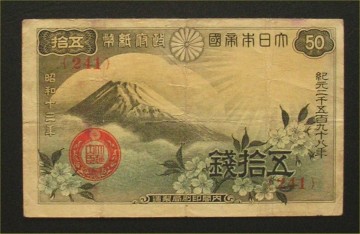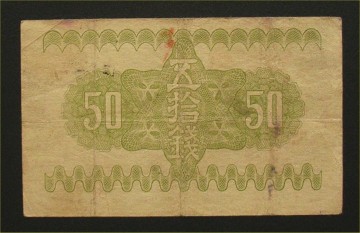 |
 |
Face value : 50 Sen 
Design : Mt. Fuji and Cherry blossoms
Issue : June, 1938 (Showa era, year 13)AAbolition : August, 1948 (Showa era, year 23)
Size : 65mm X 105mm
|
 Mount Fuji (Fuji-san) is the highest mountain (3,776 metres : 12,388 feet) on the island of Honshu and indeed in all of Japan. It straddles Shizuoka and Yamanashi prefectures in central Japan just west of Tokyo, from which it can be seen on a clear day. It is located near the Pacific coast of central Honshu.
Mount Fuji (Fuji-san) is the highest mountain (3,776 metres : 12,388 feet) on the island of Honshu and indeed in all of Japan. It straddles Shizuoka and Yamanashi prefectures in central Japan just west of Tokyo, from which it can be seen on a clear day. It is located near the Pacific coast of central Honshu.
Fuji-san is sometimes referred to as Fuji Yama in some Western texts, because the third character of its name, "san" meaning mountain, can also be pronounced "yama". However, this name is obsolete in Japan. In fact, the Japanese phrase "Fujiyama, geisha" means the Japan that is misunderstood by the West. The suffix -san, meaning a mountain, has nothing to do with the Japanese title -san used for people.
Mount Fuji is a well-known symbol of Japan and is frequently depicted in art and photographs, as well as visited by sightseers and climbers.
Climbing Mount Fuji :
The most popular period for people to hike up Mt. Fuji is from July 1 to August 27. The ascent can take anywhere between 3 and 7 hours while the descent can take from 2 to 5 hours. The hike is divided into ten stations and there are paved roads up to the fifth station, which is about 2300 meters above sea level. Thousands climb Mt. Fuji during this two-month period. Most climb during the night to watch the sun rise in the morning. The sheer number of climbers each year has created something of a trash problem on the road to the summit, but this has not decreased the mountain's popularity.
|
Copyright © 2005-2020 Nippon Kindai Banknote. All Rights Reserved.
|